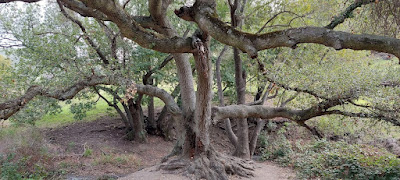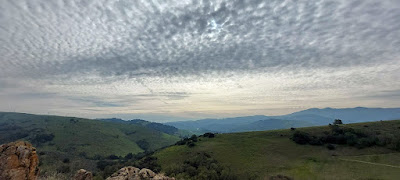Waning Crescent Moon
On another perfect, crisp, cloudless day for hiking, I drove up to Castle Rock State Park near Saratoga to hike the Saratoga Gap loop trail and visit Goat Rock, one of the Nifty Nineties. I was also hoping to see a good flow at Castle Rock Falls, which is on the way and part of the loop hike that skirts one of the many ridges in the Santa Cruz Mountains. This park and much of the surrounding area showcase the Oligocene Vaqueros sandstone formation and its signature tafoni. The ridges look like forested waves and the tafoni come in so many varieties of shapes and sizes that they defy the imagination. They can be fist-sized and shallow to cave-sized and deep enough to crawl into. For those folks who are unable to hike the trails here, Indian Rock is a beautiful outcrop right next to Skyline Boulevard. A parking area provides good access.



Castle Rock Falls is a quick hike from the trailhead, following the loop trail in a clockwise direction. The spring-sourced falls drop dramatically about 80 feet almost straight down in a gorgeous, wooded setting. To prevent most of the daredevil selfie takers from plunging to certain death, the thoughtful park administrators have erected a viewing platform with sturdy metal rails. Judging from the well used trails that descend around the safety platform, lots of nimble shutterbugs risk their lives anyway. What can you do? On this particular day, the flow was just a thin, but steady ribbon of water that gave me a hint of what it might be like in a period of regular rainfall. It was still fun to be there and the sound was captivating.

The trail along the ridge below Goat Rock is sunny and rocky, a little bit of a challenge for old knees, but not more than I could manage. There were several places where I scrambled in a crouch through tricky sandstone boulders. The rest of it was pretty normal up and down single track. It was good, sweaty fun as the day warmed up and the trail became more exposed.
Eventually, the trail loops around past the Castle Rock Trail Camp and heads toward Goat Rock through old oak and madrone forest with occasional boulder scrambles and side trails to overlooks named after people whose names I did not recognize. This area is widely known and used by climbers. Perhaps the overlook people were involved in that sport or perhaps they helped acquire the land for the park or perhaps both?


The trail approaching and leaving Goat Rock is steep and rocky, but fun to hike. I slowed way down for this part, receiving kind smiles and encouragement from youthful hikers carrying ropes and helmets. When asked, I replied, "I am in my 71st year, thank you very much." There were a couple of friendly young bucks sitting atop the rock itself. It looked like a doable hoist from the trail side. The other side was steep and would require skills and flexibility I do not possess. I was happy to be there and to inspect the various routes upwards. I had no problem deciding to move on after a snack and a swig of water. The steepest part of the trail turned into the easiest part due to a set of stairs provided by those busy park people. Thank you so much.
"I'm learning to fly, but I ain't got wings, coming down is the hardest thing." - Tom Petty.
It was uphill and less rocky most of the way after that, with lots of beautiful trees and tafoni outcrops. One outcrop had smallish rounded boulders still embedded in the sandstone matrix, giving me a glimpse into how some of the tafoni may have formed. Some day, slightly acidic rain water (pH ~ 5.5) may soak into the rock and dissolve enough of the calcareous (calcium carbonate) cement holding the sandstone together to allow the boulders to escape their prison, leaving behind a curious depression. That's my story and I'm sticking to it. At least until somebody who is more schooled in sedimentology tells me something different. I ain't proud.

Overall, this is a great trail to exercise your gluteus maximus, work up a sweat, and ponder the mysteries of Oligocene deposition, compaction, and cementation, plus subsequent tectonic movement along the San Andreas, not to mention the acrobatic hijinks of rubber-jointed, agile rock climbers. What a great way to get to know a little piece of California.
Peace, Love, and Tafoni,
Jim





















































